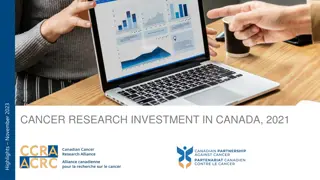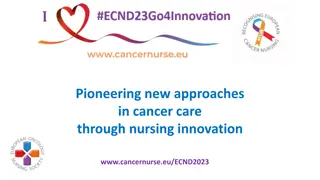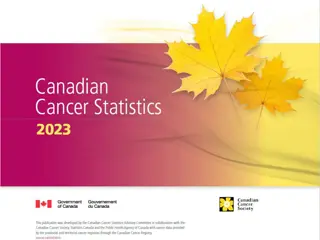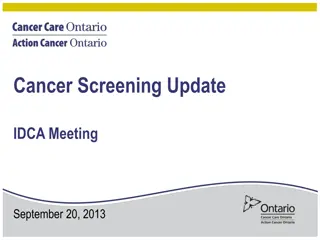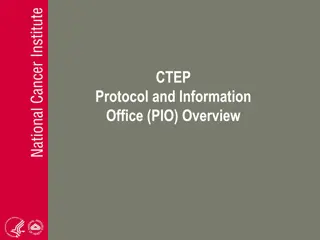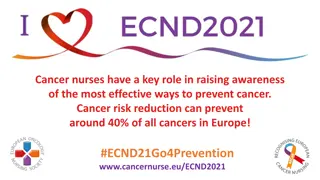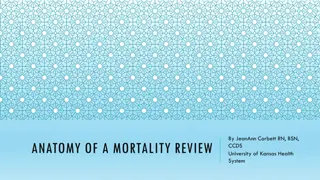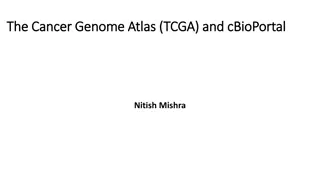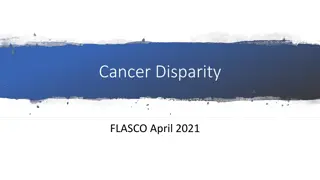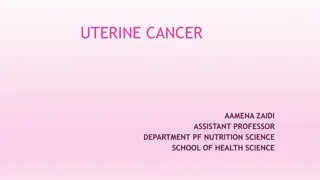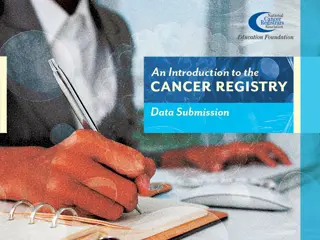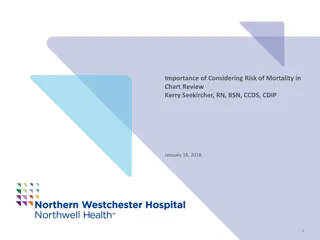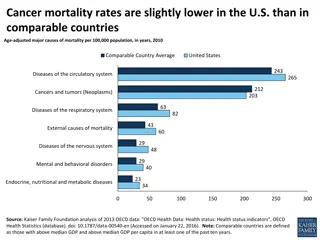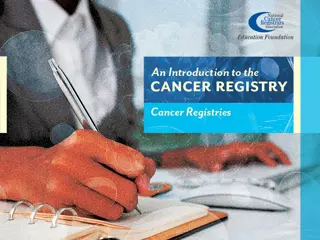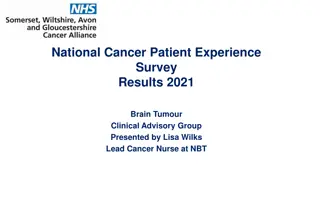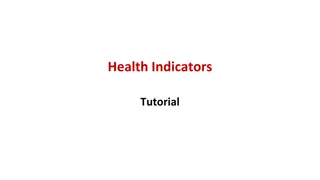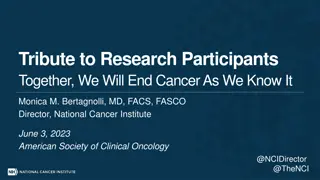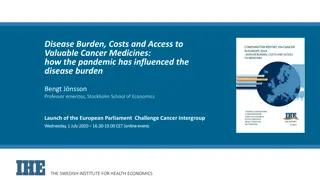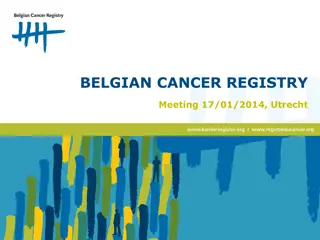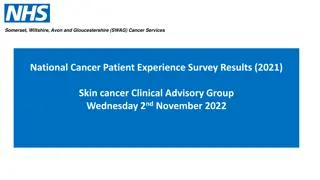What you need to know about the HPV Vaccine
Globally, cervical cancer is the fourth most common cancer in women, with 6,04,000 new cases in 2020. Women living with HIV are 6 times more likely to develop cervical cancer, compared to the general population, and an estimated 5% of all cervical cancer cases are attributable to HIV. The contributi
3 views • 7 slides
Insights on Infant Mortality and Safe Sleep Practices in Illinois
Exploring the definitions of infant mortality and safe sleep practices, this content delves into the Infant Mortality Ratio (IMR) and Sudden Unexpected Infant Death (SUID) Mortality Ratio. Data sources such as vital records and the Pregnancy Risk Assessment Monitoring System (PRAMS) shed light on th
0 views • 57 slides
Cancer Research Investment in Canada - Highlights November 2023
The Canadian Cancer Research Alliance (CCRA) is a collaboration of organizations funding cancer research in Canada to advance prevention, diagnosis, and treatment. Established in 2005, CCRA has grown to over 35 members and published strategic plans to enhance cancer research outcomes. The Alliance s
2 views • 40 slides
Pioneering new approaches in cancer care through nursing innovation
Pioneering cancer nurses in Europe are driving advancements in cancer care through innovative approaches, evidence-based knowledge, and personalized patient-centered care. They play a vital role in cancer prevention, healthcare policy enhancement, and education improvement. By putting patients and f
0 views • 12 slides
Europe Cancer Diagnostics Market: Emerging Trends in Liquid Biopsy and Next-Gene
The Europe Cancer Diagnostics Market is projected to reach $12.21 billion by 2031, at a CAGR of 5.6% during the forecast period 2024\u20132031. The Europe cancer diagnostics market is driven by the rising prevalence of cancer, supporting initiatives for early cancer diagnosis, increasing investments
3 views • 4 slides
Canadian Cancer Statistics 2023 Overview
The Canadian Cancer Statistics 2023 report provides a comprehensive analysis of cancer data, including trends, statistics, and insights for the year. The report covers various aspects of cancer, such as incidence rates, survival rates, types of cancers diagnosed, and advancements in cancer treatment
0 views • 31 slides
Ontario Breast Cancer Screening Program Overview
The Ontario Breast Screening Program (OBSP) is a quality-assured, population-based breast cancer screening initiative administered by Cancer Care Ontario. It aims to reduce breast cancer mortality through early detection by providing biennial screenings for average-risk women aged 50-74 and annual s
3 views • 21 slides
Cancer Therapy Evaluation Program (CTEP) Overview
The Cancer Therapy Evaluation Program (CTEP) aims to enhance cancer patients' lives by advancing cancer treatment through research and clinical trials. The Program includes a Protocol and Information Office (PIO) to streamline trial development processes. It funds national cancer research and focuse
0 views • 27 slides
Maternal and Child Health Indicators: Objectives and Mortality Rates
Maternal and Child Health (MCH) services aim for the reduction of maternal, perinatal, infant, and childhood mortality and morbidity, promotion of reproductive health, and physical and psychological development of children and adolescents within families. The indicators focus on mortality rates, inc
0 views • 31 slides
A Multi-disciplinary Analysis of Service Access, Community Resilience, and Maternal Mortality in Gulf Province
This paper presents a comprehensive analysis focusing on service access, community resilience, and maternal mortality in Gulf Province, Papua New Guinea. It highlights the importance of improving referral systems for maternal health in remote communities and discusses the preliminary findings from a
1 views • 53 slides
Empowering Cancer Prevention Through Nurse-Led Initiatives
Cancer nurses play a crucial role in raising awareness about effective cancer prevention methods, supporting the European Code Against Cancer, providing advice for risk reduction, promoting health literacy, and encouraging early diagnosis through screening programs. Their expertise and leadership ar
0 views • 30 slides
Understanding Mortality Reviews and Their Impact on Quality of Care
Mortality reviews play a vital role in assessing the quality of care provided by healthcare facilities. By analyzing observed versus expected mortality rates, healthcare organizations can identify areas for improvement and enhance patient outcomes. The APR-DRG system, including Severity of Illness a
0 views • 17 slides
Understanding the Cancer Genome Atlas (TCGA) Project
The Cancer Genome Atlas (TCGA) project, initiated in 2005, aims to identify genetic mutations in cancer through genome sequencing. Supervised by the Center for Cancer Genomics, TCGA has expanded over the years, publishing numerous research articles and involving various tumor types. The project has
0 views • 7 slides
Cancer Survival Rates in Europe: Trends and Disparities
Cancer survival rates in Europe have shown variations across different types of cancer and countries. While overall cancer mortality has increased over the years, some countries have experienced declines in mortality rates. Survival rates for breast cancer between 1995-2014 ranged from 74% to 89%, w
0 views • 17 slides
Understanding Cancer Health Disparities and Initiatives
Exploring the concept of cancer health disparities, this content touches on the National Cancer Act of 1971, the impact of social determinants of health, and various initiatives such as the National Minority Cancer Awareness Week. It highlights efforts to reduce disparities through research, advocac
6 views • 8 slides
Child, Maternal, and Adult Mortality in Ethiopia: A Study on Age-Cause-Specific Mortality Distribution
The study focuses on the mortality rates in Ethiopia, highlighting the challenges in rural areas and the high maternal mortality. It discusses the implementation of CRVS and the use of VAs to identify causes of death, particularly in rural regions. The objectives include analyzing age-cause-specific
0 views • 25 slides
Understanding Cancer: Causes, Symptoms, and Prevention
Cancer is a disease characterized by the uncontrollable growth and spread of abnormal cells in the body. These cells form tumors that can be either cancerous (malignant) or non-cancerous (benign). Cancer can develop in various parts of the body and is often caused by genetic changes that affect cell
3 views • 21 slides
Understanding Data Submission in Cancer Registry Systems
Data submission in cancer registry systems serves the purpose of contributing to a larger pool of information for monitoring cancer trends, determining patterns, guiding program planning, and assisting public health professionals. Organizations like the State Central Cancer Registries and national p
1 views • 11 slides
Advances in Anticoagulation Therapy for Cancer-Related VTE and Stroke
Recent studies have shown advancements in anticoagulation therapy for cancer patients with venous thromboembolism (VTE) and stroke prevention. Direct oral anticoagulants (DOACs) are now considered beneficial for treating VTE in cancer, offering advantages in administration and efficacy. Different an
3 views • 9 slides
Liverpool Health Partners Cancer Programme: Enhancing Cancer Outcomes Through Collaborative Research
Liverpool Health Partners (LHP) Cancer Programme led by Prof. Andrew Pettitt and Dr. Matina Tsalavouta aims to reduce cancer incidence and mortality, improve patient quality of life, and align with the One Liverpool strategy. The comprehensive strategy focuses on inclusive consultation, engagement,
2 views • 13 slides
Understanding the Importance of Mortality Risk in Chart Review
The presentation by Kerry Seekircher highlights the significance of considering the risk of mortality in chart reviews. It covers the benefits of conducting a mortality review, emphasizes the need for accurate documentation and coding of diagnoses, and explains the concept of risk-adjusted mortality
0 views • 50 slides
Cancer Mortality Rates and Spending Insights
Cancer mortality rates in the U.S. are slightly lower compared to other countries, with circulatory diseases and cancers being major causes of mortality. Lung cancer is a significant contributor to disease burden, especially among males. Despite cancer accounting for 7% of health expenditures, it wa
0 views • 6 slides
Humber, Coast and Vale Cancer Alliance - Cancer Champions Programme Overview
The Humber, Coast and Vale Cancer Alliance's Cancer Champions Programme, led by Trish Rawnsley, aims to raise awareness and promote early diagnosis of cancer. Developed in North East Lincolnshire in 2011, the program has trained almost 1,000 individuals, resulting in lower emergency presentations in
0 views • 10 slides
Understanding Cancer Registries and Their Significance
Cancer registries serve as vital information systems for collecting, storing, and analyzing cancer data to aid in research, prevention, treatment, and public health efforts. They help track cancer incidence, assist in identifying trends, and provide essential information to healthcare professionals
0 views • 18 slides
Patient Mobility and Cancer: Role of Joint Actions in European Cancer Care
Activities focusing on standardizing cancer care in Europe include quality assurance of screening programs, defining survivorship, establishing Comprehensive Cancer Control Networks, addressing socio-economic inequalities, and promoting public health genomics. The European Cancer Patient Coalition e
0 views • 7 slides
National Cancer Patient Experience Survey 2021 Results Overview
National Cancer Patient Experience Survey (NCPES) for 2021 focused on brain tumour patients and was led by Lisa Wilks, the Lead Cancer Nurse at NBT. The survey, commissioned by NHS England, aimed to monitor cancer care progress, drive quality improvements, and inform stakeholders. Methodology includ
0 views • 26 slides
Alcohol and Cancer Risk: Understanding the Links
Alcohol consumption is linked to an increased risk of various cancers, including mouth, throat, esophagus, breast, liver, and colorectal cancers. Factors such as ethanol, acetaldehyde, nutrient absorption, estrogen levels, and liver cirrhosis play a role in this risk. Even light drinking can elevate
0 views • 17 slides
Improvements in Outcomes for Patients with Early Breast Cancer Over the Past 20 Years
Presenter Carolyn Taylor and team present data on improvements in outcomes for women with early breast cancer from 1993 to 2015 in England. The study highlights patient and tumor factors, breast cancer mortality rates, long-term follow-up data, and the need for big data analysis. The research focuse
0 views • 18 slides
Debunking Common Myths About Cancer and Nutrition
The journey of cancer diagnosis brings forth various challenges, including misconceptions about nutrition. Debunking myths like soy stimulating cancer cells, sugar feeding cancer, and acidic diets curing cancer is crucial for informed decision-making. Evidence shows that soy can be a part of a healt
1 views • 11 slides
Cancer Statistics in China: Incidence and Mortality Report 2014
The National Central Cancer Registry of China provided a comprehensive overview of cancer burden in China in 2014. The report covers nationwide cancer incidence, mortality rates, estimated new cases and deaths, geographic distribution, and leading cancer types by age and sex. Valuable data for evide
0 views • 20 slides
Understanding Health Indicators: Calculating Mortality Rates in Communities
Learn how to calculate various mortality rates—such as crude mortality rate, proportionate mortality, case fatality rate, and cause-specific mortality rate—using real-life scenarios from communities like Adias and Wales. Understand the significance of these rates in assessing public health outco
0 views • 16 slides
Global Cancer Statistics and Trends
The data presented showcases global cancer statistics from various years, highlighting the prevalence of different types of cancer across genders. It includes information on the estimated number of cancer cases, common types of cancers, and trends expected up to 2035. Lung cancer, breast cancer, and
0 views • 83 slides
Understanding Sub-Saharan Africa's Mortality Trajectory: Past, Present, and Future Prospects
Explore the mortality trends in Sub-Saharan Africa, focusing on infant and child mortality as well as adult mortality. Despite significant progress, challenges persist due to uneven gains globally. Child mortality has seen a substantial decline, but rates remain high. Public health interventions hav
0 views • 24 slides
Integration of Complementary Medicine in Cancer Care in Tuscany
Describes the successful integration of Complementary Medicine in the network of Cancer Departments within the Tuscan Public Healthcare System. The initiative, spearheaded by experts in both Complementary Medicine and medical oncology, has led to the development of Regional Guidelines incorporating
0 views • 4 slides
Tribute to Research Participants: Ending Cancer Together
Dr. Monica M. Bertagnolli of the National Cancer Institute emphasizes the urgent need to collaborate and achieve the Cancer Moonshot goals, focusing on reducing cancer mortality and improving cancer care experiences. The key objectives include adopting proven strategies, early detection and treatmen
0 views • 18 slides
Understanding Cancer Survival Statistics in England
Cancer survival statistics in England, analyzed in collaboration between Public Health England (PHE) and the Office for National Statistics (ONS), provide crucial insights into the effectiveness of cancer services. These statistics measure the mortality rates of cancer patients and inform various st
0 views • 25 slides
Cancer Types Spending in Europe
Learn about the spending on various types of cancer in Europe including breast cancer, colorectal cancer, prostate cancer, lung cancer, ovary cancer, and pancreatic cancer. The information is based on the Comparator Report on Cancer in Europe 2019, which covers disease burden, costs, and access to m
2 views • 7 slides
Impact of the Pandemic on Cancer Disease Burden and Costs
The presentation by Professor Bengt Jönsson highlights the evolving landscape of cancer burden and costs in Europe, emphasizing the increasing mortality rates in certain age groups. Despite a decrease in deaths in those under 65, cancer remains a significant contributor to Disability Adjusted Life
0 views • 14 slides
Overview of Belgian Cancer Registry and Research Initiatives
Belgium's national cancer registry, established in 2004, covers a population of 11 million with data available since 2004. The registry includes specific legislation and authorization for data use, ensuring quality data collection and longitudinal follow-up. Various data sources feed into the regist
1 views • 13 slides
SWAG Cancer Services National Cancer Patient Experience Survey Results 2021 Overview
The SWAG Cancer Services National Cancer Patient Experience Survey Results for 2021 provide insights into the experiences of skin cancer patients in Somerset, Wiltshire, Avon, and Gloucestershire. The survey, commissioned by NHS England, aims to monitor progress in cancer care, drive local quality i
0 views • 27 slides


